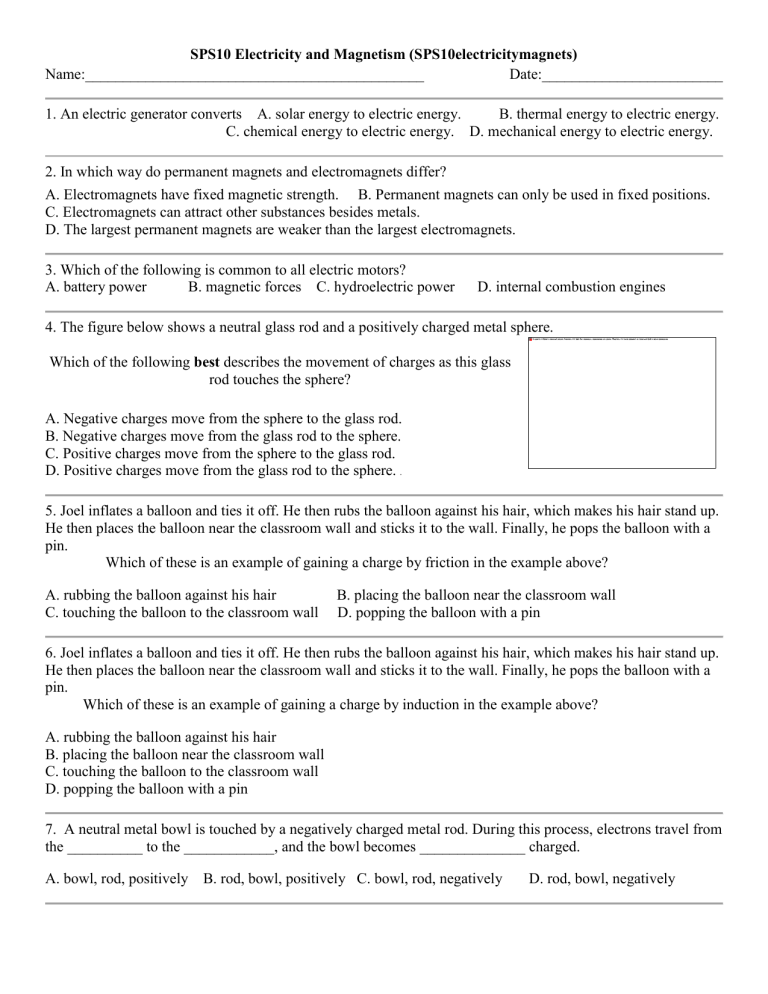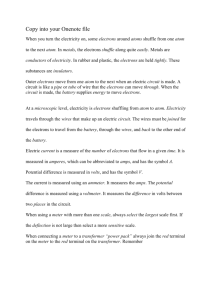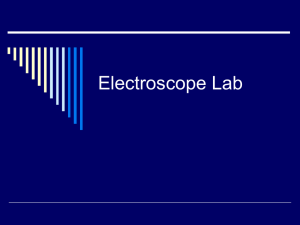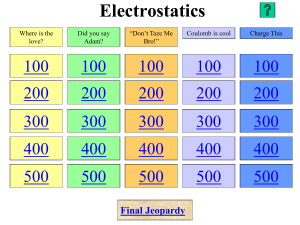SPS10 Electricity and Magnetism (SPS10electricitymagnets)

SPS10 Electricity and Magnetism (SPS10electricitymagnets)
Name:_____________________________________________ Date:________________________
1. An electric generator converts A. solar energy to electric energy. B. thermal energy to electric energy.
C. chemical energy to electric energy. D. mechanical energy to electric energy.
2. In which way do permanent magnets and electromagnets differ?
A. Electromagnets have fixed magnetic strength. B. Permanent magnets can only be used in fixed positions.
C. Electromagnets can attract other substances besides metals.
D. The largest permanent magnets are weaker than the largest electromagnets.
3. Which of the following is common to all electric motors?
A. battery power B. magnetic forces C. hydroelectric power D. internal combustion engines
4. The figure below shows a neutral glass rod and a positively charged metal sphere.
Which of the following best describes the movement of charges as this glass rod touches the sphere?
A. Negative charges move from the sphere to the glass rod.
B. Negative charges move from the glass rod to the sphere.
C. Positive charges move from the sphere to the glass rod.
D. Positive charges move from the glass rod to the sphere.
.
5. Joel inflates a balloon and ties it off. He then rubs the balloon against his hair, which makes his hair stand up.
He then places the balloon near the classroom wall and sticks it to the wall. Finally, he pops the balloon with a pin.
Which of these is an example of gaining a charge by friction in the example above?
A. rubbing the balloon against his hair B. placing the balloon near the classroom wall
C. touching the balloon to the classroom wall D. popping the balloon with a pin
6. Joel inflates a balloon and ties it off. He then rubs the balloon against his hair, which makes his hair stand up.
He then places the balloon near the classroom wall and sticks it to the wall. Finally, he pops the balloon with a pin.
Which of these is an example of gaining a charge by induction in the example above?
A. rubbing the balloon against his hair
B. placing the balloon near the classroom wall
C. touching the balloon to the classroom wall
D. popping the balloon with a pin
7. A neutral metal bowl is touched by a negatively charged metal rod. During this process, electrons travel from the __________ to the ____________, and the bowl becomes ______________ charged.
A. bowl, rod, positively B. rod, bowl, positively C. bowl, rod, negatively D. rod, bowl, negatively
8. The battery in a cell phone provides a constant flow of electrons through conductors in the same direction to power the phone. A cell phone is powered by ____________ current.
A. alternating B. direct C. ampere D. distributed
9. Electrons that flow through your toaster when it is operating A. vary back and forth in direction.
B. become more highly charged. C. move in the same direction. D. become less highly charged.
10. As electrons flow through this circuit, the voltage remains constant. If the size of the resistor were to increase,
A. the electrons would slow down. B. the electrons would speed up.
C. fewer electrons would flow through the circuit.
D. more electrons would flow through the circuit.
11. In the image, a battery is used to produce a flow of electrons through this circuit. Which of these would cause more electrons to flow through the circuit?
A. replacing the resistor with a larger one B. replacing the battery with a larger one
C. replacing the battery with a smaller one D. replacing the resistor with two equal resistors in series
12. In the example, R
1
= R
2
; as electrons flow through the circuit
A. half of electrons flow through R
1
and half flow through R
2
.
B. more electrons flow through R
2
than R
1
.
C. more electrons flow through R
1
than R
2
.
D. all electrons flow through R
1
and R
2
.
13. In the example, R
1
= R
2
; as electrons flow through the circuit
A. half of the electrons flow through R
1
and half flow through R
2
.
B. more electrons flow through R
2
than R
1
.
C. more electrons flow through R
1
than R
2
.
D. all electrons flow through R
1
and R
2
.
14. In the image, a copper wire is wrapped around a solid iron rod many times.
In order for this to produce an electromagnet, what must occur?
A. The iron rod must move back and forth.
B. The entire system must be spinning.
C. The end of the copper wires must be in direct contact.
D. There must be electrons flowing through the copper wire.
15. An automotive solenoid is an electromagnet that is used to start the car when the key is turned in the ignition. Which of these other parts must be connected to the solenoid in order for it to work properly?
A. Engine B. Battery C. Brakes D. Heater
16. As electrons flow through the metal wire in the center of this motor, the metal begins to turn. This is because
A. electric charges act as tiny magnets.
B. a flow of electrons experiences a force in a magnetic field.
C. positive electric charges are attracted to the south pole of a magnet.
D. positive electric charges are attracted to the north pole of a magnet.
17. Which of these is LEAST likely to include an electric motor?
A. telephone B. blender C. washing machine D. electric fan
18. Magnet A is pushed towards magnet B. You observe that the two magnets are attracted to each other and "stick". Which sentence BEST explains this observation?
A. Both are positively charged.
B. Both are tightly bonded to each other.
C. Both are composed of smaller, individual magnets.
D. Both have all their magnetic domains aligned in the same direction.
19. In a simple electrical circuit, electrons flow from a battery through a resistor and back to the battery. In a plumbing system, a pump moves water through pipes. If a larger pump were used to move the water through the pipes more quickly, what electrical concept is MOST like the size of the water pump?
A. resistance B. voltage C. current D. amperage
1. D) mechanical energy to electric energy.
2. D) The largest permanent magnets are weaker than the largest electromagnets.
Answer Key
11. B) replacing the battery with a larger one
12. D) all electrons flow through R
1
and R
2
.
13. A) half of the electrons flow through R
1
and half
3. B) magnetic forces
4. B) Negative charges move from the glass rod to the sphere.
5. A) rubbing the balloon against his hair
6. B) placing the balloon near the classroom wall
7. D) rod, bowl, negatively
8. B) direct
9. A) vary back and forth in direction.
10. C) fewer electrons would flow through the circuit. flow through R
15. B) Battery
2
16. B) a flow of electrons experiences a force in a magnetic field.
.
14. D) There must be electrons flowing through the copper wire.
17. A) telephone
18. D) Both have all their magnetic domains aligned in the same direction.
19. B) voltage





